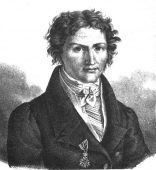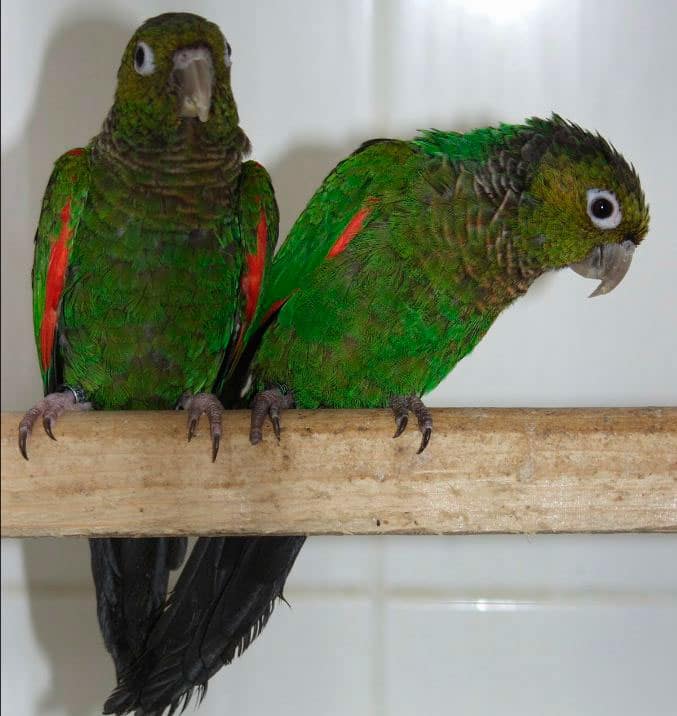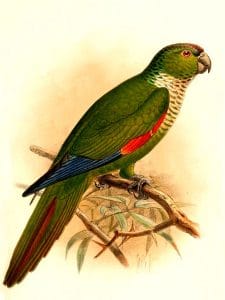Content
|
|---|
Description:
26-28 cm.. height.
The Maroon-tailed Parakeet (Pyrrhura melanura) is distinguishable mainly by the tail and wings blackish (visible in flight); has the lores, the forecrown, the crown and the rear area of the neck, brownish, with paler reddish brown tips on the crown, forming altogether a speckled pattern; cheeks, ear-coverts and area behind the eyes, green; Brown in the shadows at the back of the crown Green in the nape.
Upperparts Green with tinge of olive in some feathers. Primary coverts Red with yellow tips; Front edge of the wing , red; upperwing-coverts of color green with dye olive. Primaries Dark greenish blue with dark tips. Underwing-coverts green; underside of flight feather blackish. Throat and feathers of the upper part of the chest, Green or greyish green with pale margins, giving a scaly striking effect; pale edges that become less clear on the sides of the neck; the belly and undertail-coverts Green with dye olive dark. Upper, the tail dark brown with green outer feathers; undertail, the tail shiny black.
Bill pale grey; bare periophthalmic naked, whitish: irises dark brown; legs grey.
Both sexes similar. The immature has less red (greener) in the primary coverts.
- Sound of the Maroon-tailed Parakeet.
Subspecies description
Habitat:
The Maroon-tailed Parakeet It occupies the temperate tropical formations, including forests of várzea, forests of land low and pre-montanos rainforests and forests cloud, often in areas partially cleared and edges of secondary forests; 150 - 300m in Venezuela (nominal), to 3,200 m in the slopes Andean Eastern (souancei), 1.600-2.800m on the slope of the Andes central (chapmani), at 1,700 m in Nariño (Pacifica), at 1500m (berlepschi). Usually in flocks of 6-12 individuals, staying in them cups of them trees to rest but moving is toward the branches more low for forage.
Reproduction:
Little information about breeding, observed during the months of April-June, headers of the Napo River, Ecuador. Copulation observed in January (Colombia). Clutch four eggs in captivity.
Food:
Few details about the diet, with foods known, including fruits of Miconia tkeaezans (Top of the Magdalena valley). Fagara tachuelo and tree bark (Amazonia).
Distribution:
Size of the area of distribution (reproduction / resident): 1.510.000 km2
The distribution of the Maroon-tailed Parakeet is discontinuous. Northwest of South America in the Western Amazon basin, southern portion of the the Orinoco basin and slope of the peaceful of the Andes, in the southwest of Colombia and West Ecuador.
In Venezuela the species is found in the Centre of the South of Bolívar along the upper Western Amazon basin of Brazil between the rivers Negro and Solimões. They are also distributed in Andes Central of Colombia, at the top of the Magdalena valley, from the South of Tolima until Huila and separated to the East from the Andes (in lowlands and up to 500 m in foothills) Since the Macarena mountains, southward through eastern lowlands Ecuador and Northeast and East of Peru.
A separate population is distributed to the West of the Andes, in the Northwest of the South of Ecuador, to the North of The rivers, with a single log in nose, to the southwest of Colombia.
Mainly resident Although the apparent absence during some seasons in some parts of Colombia suggests regular movements.
Unevenly distributed, in some areas very common, being the Parrot more numerous in some parts of the range such as high Magdalena valley and perhaps parts of Esmeraldas in the Northwest of Ecuador.
Alleged decrease in some areas (for example, Pacific slope of Ecuador) due to loss of habitat. Little known in the East of Peru. Not a locally popular cage bird if it has been traded internationally in significant numbers in late 1980 and fairly well known in captivity outside of its area of distribution.
Subspecies distribution
Conservation:
• Current category of the Red List of the UICN: Least concern.
• Population trend: Decreasing.
Justification of the population
The population size world has not been quantified, but this species is described as “quite common” (Stotz et to the., 1996).
Justification of trend
This species is suspected that he has been able to lose 6,95 to 7,1% of a habitat within its distribution over three generations (18 years) based on a deforestation model of the Amazon (Soares-Filho et to the., 2006, Bird et to the. 2011). Given the susceptibility of the species to the cazay and/or the capture, It is suspected that will decrease in <25% durante tres generaciones.
"Maroon-tailed Parakeet" in captivity:
Ave shy and quiet, get used to people over time. Colonies in large birdcages are possible.
Alternative names:
– Maroon-tailed Parakeet, Magdalena Parakeet, Maroon tailed Parakeet, Maroon-tailed Conure, Black-tailed Conure (English).
– Conure de Souancé, Perriche de Souancé, Perruche de Souancé (French).
– Braunschwanzsittich, Braunschwanz-Sittich (German).
– tiriba-fura-mata (Portuguese).
– Cotorra Colinegra, Perico de Cola Negra, Periquito Colirrojo (español).
– Periquito Colirrojo (Colombia).
– Periquito Colirrojo (Peru).
– Perico Cola Negra (Venezuela).
scientific classification:

– Order: Psittaciformes
– Family: Psittacidae
– Genus: Pyrrhura
– Scientific name: Pyrrhura melanura
– Citation: (von Spix, 1824)
– Protonimo: Aratinga melanurus
Images "Maroon-tailed Parakeet"
Videos "Maroon-tailed Parakeet"
————————————————————————————————
“Maroon-tailed Parakeet” (Pyrrhura melanura)
Sources:
– Avibase
– Parrots of the World – Forshaw Joseph M
– Parrots A Guide to the Parrots of the World – Tony Juniper & Mike Parr
– Birdlife
– Photos:
(1) – pyrrhura.cz.
(2) – Maroon-tailed parakeet pyrrhura berlepschi = berlepschi, Maroon-tailed Parakeet ssp. by John Gerrard Keulemans [Public domain], via Wikimedia Commons
– Sounds: (Xeno-canto)



